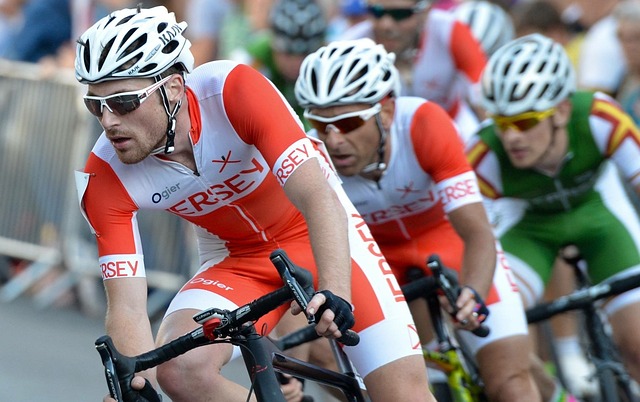
Choosing a high-quality flashlight specifically designed for night cycling is essential for ensuring visibility and enhancing safety on the roads. Such flashlights offer brightness through high lumen output, long battery life, durability against environmental factors, and versatile mounting options to cater to various cycling conditions. They feature adjustable beam patterns, including focused light for path illumination and wider beams for greater awareness of surroundings. Additionally, they should meet legal requirements, such as emitting a white light at the front and a red light at the rear, which not only follows regulations but also ensures that you are seen by other road users during low-light conditions. Flashlights for night cycling and biking complement reflective gear and lights to create a comprehensive visibility system, making nighttime cycling significantly safer. Adhering to local traffic laws regarding flashlight usage is crucial for both legal compliance and personal safety.
When the sun dips below the horizon, night cyclists face a critical challenge: visibility. As darkness envelopes roads and trails, the risk of accidents increases, making safety a top priority for those who ride after dusk. Flashlights for night cycling and biking emerge as a pivotal tool to enhance rider conspicuity and ensure a safe journey. This article delves into the necessity of being seen on the road at night, the benefits of using flashlights, how to select the most effective light for your nighttime expeditions, the correct placement for optimal visibility, and the combination of lighting techniques with reflectors and high-visibility gear. Additionally, we navigate through local regulations to ensure you’re not only seen but also compliant with legal requirements. Ride confidently under the stars with the right illumination strategy.
- Understanding the Importance of Visibility for Night Cyclists
- The Role of Flashlights in Enhancing Bike Safety at Night
- Selecting the Best Flashlight for Your Nighttime Rides
- Proper Placement and Use of Flashlights on Your Bicycle
- Techniques for Effective Lighting to Maximize Safety
- Complementary Gear: Reflectors, Lights, and High-Visibility Clothing
- Legal Considerations and Local Regulations for Night Cycling with Flashlights
Understanding the Importance of Visibility for Night Cyclists

Night cycling requires heightened awareness and visibility to ensure safety on the roads. Cyclists must be seen by motorists, especially in poorly lit areas or during adverse weather conditions. A reliable flashlight is an indispensable tool for enhancing visibility while biking at night. It not only aids in navigating pathways and roadways but also alerts others of your presence on the road. Flashlights for night cycling and biking are designed with features that securely attach to bicycles, providing consistent illumination directly ahead and to the sides. This dual-functionality ensures that you can be seen from multiple angles by other vehicles, pedestrians, and even wildlife. The brightness of these flashlights can range from a steady stream of light to flashing modes that capture attention without blinding oncoming traffic. When selecting a flashlight for night cycling, consider the lumen output, battery life, durability, and mounting options to match your cycling environment and preferences. Investing in a high-quality flashlight can significantly enhance your safety and comfort while enjoying nighttime rides. It’s not just about being seen; it’s about choosing the right tool to navigate the challenges of night cycling safely.
The Role of Flashlights in Enhancing Bike Safety at Night

When cycling at night, visibility becomes paramount for ensuring safety and sharing the road with other vehicles and pedestrians. Flashlights for night cycling and biking serve as a critical tool in this context, providing illumination that goes beyond the limitations of conventional bike lights. Unlike headlamps or taillights, flashlights offer a focused beam that can light up the path ahead or highlight potential hazards on the road, such as potholes, debris, or unexpected turns. This directed light not only enhances the cyclist’s ability to see but also significantly increases their visibility to motorists. A well-placed handlebar-mounted flashlight can attract attention, signaling a cyclist’s presence in a way that is hard to ignore. Additionally, flashlights for night cycling and biking come with various settings, including high and low light modes, which can extend battery life and ensure the rider has consistent visibility throughout their journey. Their versatility makes them an indispensable addition to any cyclist’s gear, especially when riding in areas with minimal street lighting or during early morning commutes. The strategic use of flashlights in conjunction with standard bike lights can significantly improve safety and confidence for nighttime cyclists.
Selecting the Best Flashlight for Your Nighttime Rides

When embarking on nighttime rides, visibility is paramount for safety. A reliable flashlight for night cycling and biking can significantly enhance your presence on the road and deter potential accidents. To select the best flashlight for your evening or nighttime bicycle excursions, consider several key factors. Firstly, luminosity plays a crucial role; opt for a light with a high lumen output to ensure you are seen from afar. Additionally, the beam pattern should be focused and directed precisely where it matters most—on the path ahead and on your person. A flashlight that offers multiple modes, including steady and flashing settings, can increase visibility and also serve as a signaling device in case of emergencies.
Durability is another important aspect when choosing a flashlight for night cycling and biking. Flashlights designed with robust materials and impact-resistant lenses will endure the rigors of travel on your bike. Moreover, water resistance is essential to protect the light from the elements, ensuring its reliability even in adverse weather conditions. The design should also allow for easy attachment to your bicycle, whether it’s through a helmet, handlebars, or frame bracket. Consider models with versatile mounting options and those that can be easily operated with gloves on, as dexterity may be limited while cycling. A securely mounted flashlight will provide consistent illumination, reducing the risk of shadows obscuring your path and enhancing your overall safety during nighttime rides.
Proper Placement and Use of Flashlights on Your Bicycle

When cycling at night, ensuring that you are visible to other road users is paramount for your safety. Flashlights for night cycling and biking serve as an essential tool in enhancing your visibility and providing illumination for your path. Proper placement of these flashlights on your bicycle can significantly improve your safety. A front white light, often required by law, should be mounted securely on the handlebar facing forward to illuminate the road ahead and make your presence known to other vehicles. This not only helps in seeing potential hazards but also in being seen from a distance. The intensity of the beam should be such that it does not dazzle you or blind other drivers as you ride.
In addition to the front light, attachment points on the back of your bicycle are ideal locations for red rear lights. These flashlights for night cycling and biking can be affixed to the seat post, seat stay, or a bike rack. Red lights are less likely to cause distraction or discomfort when seen from the rear, ensuring that you are clearly visible to traffic behind you. For additional safety, consider using reflectors on your spokes, pedals, and frame, as they can catch light from vehicle headlights and increase your visibility during encounters with motorists. Strategic placement of flashlights, combined with the correct usage, can greatly enhance your safety and comfort while night cycling and biking, making it an indispensable practice for all cyclists navigating low-light conditions.
Techniques for Effective Lighting to Maximize Safety

When pedaling under the cover of darkness, visibility is paramount for the safety of night cyclists. Flashlights for night cycling and biking serve as a critical tool in enhancing one’s presence on the road. To maximize safety, it’s crucial to position the flashlight effectively. Mounting the light directly on the handlebars can illuminate immediate surroundings, allowing riders to navigate obstacles and potholes. However, for a broader perspective and to see further down the path or trail, attaching the flashlight to the helmet or the bike’s frame above the handlebars can provide a more expansive light beam. This positioning also reduces glare on the path ahead, which is beneficial for both the cyclist and approaching vehicles.
The intensity and pattern of the light also play significant roles. A focused beam can cut through the darkness and highlight objects that might otherwise be hidden in shadow. Many flashlights for night cycling and biking offer adjustable brightness levels and different lighting modes, including steady beams, strobing, or flashing patterns. These settings not only help in increasing visibility but can also serve as a signaling tool to alert others of your presence. Riders should experiment with these features to find the most effective pattern for their environment and riding conditions. Reflective gear and clothing complement flashlights by reflecting incoming light back to the source, ensuring that cyclists are visible from all angles. By integrating these lighting techniques and technologies, night cyclists can significantly enhance their safety and enjoy a more secure and comfortable ride after dark.
Complementary Gear: Reflectors, Lights, and High-Visibility Clothing

When enhancing your bike safety at night, complementary gear such as reflectors, lights, and high-visibility clothing work in tandem with a flashlight for night cycling and biking to ensure you’re seen by motorists. Reflectors are essential for catching the light from oncoming vehicles and casting a visible beam behind you, which is crucial for alerting trailing drivers of your presence. They are typically affixed to the spokes, pedals, seat post, and frame of your bicycle, optimizing your visibility in various angles of light.
Lights, however, provide direct illumination that can be aimed exactly where needed. A well-placed headlight will not only light up your path but also make you more visible to others. Taillights serve a similar purpose by ensuring that your rear is clearly defined against the darkness, signaling your stopping intentions and maintaining a safe following distance. For maximum effectiveness, both front and rear lights should be used, as they can increase your visibility from multiple directions. High-visibility clothing, often in bright colors or with reflective elements, complements these light sources by day and enhances them by night. When combined with a flashlight for night cycling and biking, which can illuminate obstacles in your path or help you navigate through poorly lit areas, your chances of being seen and avoiding potential collisions are significantly improved. This trifecta of safety gear not only makes you more noticeable but also helps you to see and react to your surroundings, promoting a safer experience for all who share the road.
Legal Considerations and Local Regulations for Night Cycling with Flashlights

When navigating the roads at night, cyclists must adhere to legal considerations and local regulations that govern visibility and safety. Flashlights for night cycling and biking are not merely tools for illumination but often a requirement under transportation laws. It is imperative for riders to be aware of their jurisdiction’s specific stipulations regarding lighting equipment. Many regions mandate the use of white front lights and red rear reflectors or lights to ensure that cyclists are visible to motorists, as outlined in traffic codes. These lights not only comply with legal standards but also significantly enhance a cyclist’s safety by improving their conspicuity on dark roads. Furthermore, understanding local regulations can prevent fines and promote safer travel practices. Cyclists should verify the legality of flashlight placement and brightness levels according to their city or state’s guidelines, as these factors can vary. Adhering to these rules not only fulfills a legal obligation but also contributes to the collective effort of maintaining road safety for all users, including cyclists who venture out after dusk.
In conclusion, prioritizing visibility while cycling at night is not just a safety measure but an essential practice for any rider. Utilizing flashlights as part of your lighting setup, as discussed, can significantly enhance your safety on the road. Selecting the right flashlight for night cycling and biking—one that meets your specific needs—and strategically placing it on your bicycle are critical steps to ensure you are seen by motorists. Combining this with reflectors, lights, and high-visibility clothing creates a comprehensive lighting strategy that can keep you safe while adhering to local regulations. It’s clear that being well-lit at night not only allows for better navigation of the road but also plays a vital role in preventing accidents and ensuring your ride is as secure as possible. Riders should always stay informed about their legal obligations regarding lighting equipment, ensuring they are both safe and compliant with local laws. With careful selection and proper use of flashlights for night cycling and biking, you can ride confidently under the cover of darkness.







